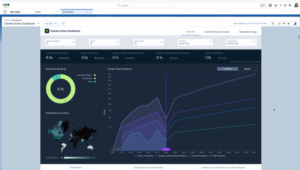Table of Contents
Analyzing current marketing trends is essential for companies to stay competitive, identify opportunities for innovation, optimize their marketing strategies, manage risks, understand consumers, and ultimately, maximize their success in a fast-paced and ever-changing industry. Doing so will allow to:
- Take an insight into the future: They help to anticipate future developments in various fields, including technology, economics, fashion, and culture. By understanding current trends, businesses can prepare for what’s to come and adapt accordingly.
- Strategic Decision-Making: Businesses can use trend analysis to make informed decisions about product development, marketing strategies, and investments to stay ahead of the competition and capitalize on new opportunities.
- Risk Management: Trends analysis can also identify potential risks and threats.
- Innovation and Creativity: Trend analysis can inspire innovation by highlighting new ideas, technologies, and consumer preferences as it provides valuable insights into purchasing patterns, social media engagement, and cultural shifts.
- Adaptation to Change: Trends analysis helps organizations adapt to changing circumstances by providing early warnings of shifts in market conditions, societal norms, or technological advancements.
As we have already highlighted the relevance of staying up to date with the marketing trends for 2024, it’s time to dive deep into them.
01
of 07
AI-driven Marketing
AI is all that anyone ever talks about, but the reality is that AI and machine learning are transforming all sectors!
For example, the UK is ranked first in Europe and third globally, boasting a strong AI ecosystem with research institutions, universities, and a diverse set of AI companies. The UK government supports AI development and deployment through funding initiatives, policies, and dedicated teams within various departments. Take the Netherlands, for instance. They recognize AI as a key innovation sector and have dedicated significant resources to its growth, including a €1.05 billion investment over five years through the NL AI Coalition.
Amazon Web Services’ study “Unlocking Portugal’s ambitions for artificial intelligence in the digital decade” concludes that the impact of adopting artificial intelligence (AI) on Gross Value Added (GVA) over the next six years could reach 61 billion euros – just in the country. The study also concluded that 35% of companies in Portugal have already adopted AI technology, showing a growth of 25% since 2022.
For this reason, AI and machine learning can not be left out of this list, as they are likely to play an even more significant role in marketing by 2024. Marketers will increasingly leverage AI for personalized targeting, content optimization, customer service automation, and predictive analytics.
As an example, AI-driven chatbots and messaging applications are transforming customer engagements by delivering tailored experiences and immediate resolutions, fostering deeper customer relationships. Consequently, companies are currently interacting with customers, addressing inquiries, and steering buying choices. In response to the contemporary demand for instant satisfaction, these tools provide tailored encounters, significantly elevating overall customer satisfaction. Learn more about optimizing your customer experience by exploring our article on integrating WhatsApp with Salesforce and discover how chatbots can seamlessly enhance your Salesforce integration for superior customer interactions.

02
of 07
Immersive Technologies
Augmented Reality (AR) and Virtual Reality (VR) technologies offer immersive experiences that brands can leverage for product demonstrations, virtual try-ons and events, and interactive storytelling.
In 2024, they are expected to be a part of the marketing strategies and campaigns in a deeper way as they are becoming more accessible and can increase the brand value and customer experience – a good example is how IKEA created IKEA Kreativ to allow customers to visualize how the furniture and decor will play out together or Nike’s “SNKRS” app allows customers to virtually try on shoes before purchasing them.
03
of 07
Personalization
Tailoring marketing messages, products, recommendations, offers, and experiences to individual preferences and behaviors continues to be crucial. AI and data analytics are driving advancements in personalization.
A 2023 study by Epsilon found that 80% of consumers are more likely to buy from a company that provides personalized experiences. Additionally, the study revealed that personalized emails deliver 6 times higher transaction rates than non-personalized emails.
To face the amount of information and offers that are out there, today’s consumer expects tailor-made experiences that make a difference in their experience. So by analyzing past purchases, browsing history, and engagement patterns, companies are now able to offer a better and faster experience for consumers, capturing their preferences and needs more effectively.
However it is essential to mention in this topic that businesses must act responsibly when handling customer data, explaining how your business collects and uses this data and obtaining explicit consent – and this leads us to the next topic.
04
of 07
Data Privacy and Trust
With growing concerns about data privacy and security, transparency in data collection and usage is paramount. Building trust with consumers by prioritizing their privacy rights is crucial for long-term success. This year, strategies and businesses that demonstrate a commitment to this matter will fortify their reputation as trustworthy custodians of customer data and will likely gain an advantage over the competition.
For instance, cookies are a common tool used for data collection on websites, often enabling personalization and targeted advertising. However, their use can raise privacy concerns if not done transparently and with user consent.
Here’s how businesses can build trust with consumers while utilizing cookies:
- Transparency: Clearly explain what data is collected through cookies, how it is used, and the benefits it provides to the user (e.g., personalization, improved user experience).
- Consent: Obtain explicit consent from users before placing non-essential cookies on their devices. This could involve providing clear and concise information about cookies and offering granular control over consent options.
- Choice: Allow users to easily manage their cookie preferences, including opt-out options and the ability to delete stored cookies.
- Compliance: Adhere to relevant data privacy regulations like GDPR and CCPA to ensure responsible data handling practices.
By implementing these practices, businesses can leverage cookies for personalization and targeted advertising while ensuring user privacy and building trust with their consumers. This can lead to a positive impact on brand reputation, customer satisfaction, and, potentially, increased customer loyalty and conversions.
05
of 07
Sustainability and Social Responsibility
Consumers are increasingly conscious of environmental and social issues as challenges like climate change and social injustices arise. They don’t just buy a product: instead, they first evaluate the values of the brand and then they consider whether to buy or not the product or service. Brands prioritizing sustainability, ethical practices, and social responsibility can build stronger connections with socially conscious consumers.
So, brands that authentically integrate sustainability into their campaign messaging and business operations could see increased consumer trust and loyalty. This matter relies on the importance of, not only showing that your company is concerned with Sustainability and Social Responsibility but also effectively doing so – for example by adopting an eco-friendly experience (packages and distribution) or monitoring the carbon footprint.
Salesforce Net Zero is a suite of tools designed to help businesses track, manage, and reduce their carbon emissions. Net Zero Cloud’s transparency features allow companies to communicate their sustainability efforts effectively, fostering trust with consumers who want to understand a company’s commitment to social responsibility.

06
of 07
Voice Search and Smart Speakers
Voice search and smart speakers are expected to continue shaping the way consumers interact with brands because the prevalence of smart speakers and voice-activated assistants continues to increase. Thus, developing conversational AI strategies and optimizing content for voice search by creating voice-friendly experiences, is essential.
Ever heard of Domino’s Pizza? Their success in utilizing voice search and smart speakers for customer engagement serves as a prime example of how this technology can positively impact the business landscape. Domino’s voice ordering simplifies the ordering process, making it faster and more convenient for customers, especially those with busy schedules or who are multitasking.
Users can repeat their previous orders or customize them through voice commands, offering a hands-free and intuitive experience. Domino’s reported a significant increase in sales through voice-activated devices, demonstrating the technology’s effectiveness in driving customer engagement.
07
of 07
Video Marketing
Video content isn’t new but remains highly engaging and is expected to continue dominating digital marketing strategies. Short-form videos, live streaming, and interactive video experiences are particularly popular, so companies that effectively utilize these dynamic trends will be able to communicate their brand messages engagingly.
The emergence of platforms such as TikTok, YouTube Shorts, and Instagram Reels has exacerbated its ever-growing population. Companies are now exploiting short-form videos for narrative purposes, product debuts, and even client endorsements, stimulating word-of-mouth marketing.
For example, Duolingo utilizes TikTok and Instagram Reels to create educational and entertaining language learning content, attracting a younger audience and promoting their language learning app. Duolingo recognized the unique qualities of TikTok: its focus on short-form, engaging content and its predominantly younger user base. They tailored their content for this platform, utilizing humour, trending sounds, and relatable scenarios to connect with their target audience.
Duolingo boasts over 7.8 million followers on TikTok with their videos garnering millions of views. Between January 2022 and January 2023, their monthly active users grew by 59.4% globally.
These trends reflect broader shifts in technology, consumer behaviour, and societal values that could shape the marketing landscape in 2024. However, it’s essential to monitor the evolving marketing landscape closely for emerging trends and adapt strategies accordingly. To do so, keep updated by subscribing to our Knowledge Center!







